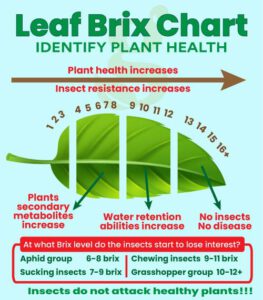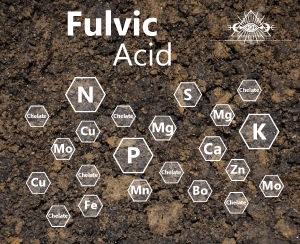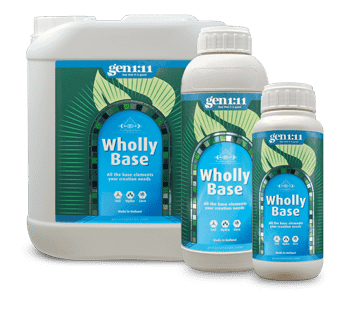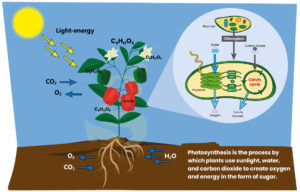
Brix in relation to crop health and quality
Brix in relatie tot gezondheid en kwaliteit van gewassen. De zoete wetenschap van Brix. Brix in relatie tot gezondheid en kwaliteit van gewassen. Brix-waarde verwijst
More yield from better quality
All in just 5 products
25+ years of fertilizer experience
Better and cheaper
Easy to use
Humic substances are humates that are an essential part of organic soil material, play a crucial role in soil fertility and plant nutrition. These substances consist of humic acid and fulvic acid. Each with different so its properties and functions. In this article, we discuss the characteristics of humic acid, explore the benefits of fulvic acid compared to humic acid and highlight their importance as fertilisers in improving crop development.
Humic acid is a complex organic compound derived from the decay of plant and animal remains in the soil. It is characterised by its high molecular weight and dark colour and contributes to the total organic matter content in soil. Humic acid is a macromolecule composed of several functional groups that give it unique chemical properties.
One of the main functions of the two humates in soil is their ability to chelate essential nutrients. This makes them more available to plants. Chelation involves the formation of stable complexes between the empty molecules of humates and mineral ions. This increases their solubility. This improves the uptake of nutrients by plant roots, promoting growth and development.

Humates also play a vital role in improving soil structure. It improves soil aggregation, leading to better water retention and aeration. The improved structure promotes root penetration, nutrient uptake and overall plant health. In addition, it promotes microbial activity in the soil, creating a favourable environment for beneficial microorganisms.
Fulvic acid is the other humate. The smaller molecular size of fulvic acid allows it to penetrate plant cell walls more easily. This facilitates the transport of nutrients directly to plant cells. Fulvin molecules in a free-form or an acid without minerals chelate (capture) minerals and create fulvates that transport and release minerals into the cell. These free-form fulvin molecules are ideal as nutrient activators because it optimises nutrients in an existing culture schedule. This enhanced nutrient supply can lead to improved metabolic activities of the plant, increased resistance to stress and overall better crop yields.
The smaller molecular size of fulvic acid allows it to penetrate plant cell walls more easily. This facilitates the transport of nutrients directly to plant cells. Fulvin molecules in a free-form or mineral-free acid chelate (capture) minerals and create fulvates that transport and release minerals into the cell. These free-form fulvin molecules are ideal as nutrient activators because it optimises nutrients in an existing culture schedule. This enhanced nutrient supply can lead to improved metabolic activities of the plant, increased resistance to stress and overall better crop yields.
Unlike humic acid, fulvic acid is viable in a much wider pH spectrum. Moreover, fulvic acid has superior pH buffering capacity, which helps maintain optimal pH levels in the soil. This is especially valuable in acidic or alkaline environments. Here, fulvic acid can reduce the adverse effects of extreme pH conditions on nutrient availability. This buffering effect contributes to a more stable and conducive environment for plant growth.
Fulvinic acid is known for its antioxidant properties, which can protect plants from oxidative stress caused by environmental factors, such as drought, UV radiation and pollutants. The antioxidant capacity of fulvic acid can increase plant resilience, leading to improved crop quality and yield.
The benefit of using humates in agriculture and horticulture in the Netherlands has already convinced many growers of the added value of this natural product. Humic substances, consisting of humic acid and fulvic acid play a central role in the overall health of soil and crop. While humic acid excels in chelating nutrients and improving soil structure, fulvic acid offers unique benefits such as superior nutrient transport, pH buffering and antioxidant properties.

At Gen1:11, fulvic acid is simply in the basic nutrients.
Gen1:11 has added fulvinic acid to the Gen1:11 Wholly Base so that your plant can benefit throughout the cycle from the added value of the exceptional properties of this organic acid.

Brix in relatie tot gezondheid en kwaliteit van gewassen. De zoete wetenschap van Brix. Brix in relatie tot gezondheid en kwaliteit van gewassen. Brix-waarde verwijst

Het endocannabinoïde systeem begrijpen Een korte handleiding voor CB1- en CB2-receptoren Het endocannabinoïde systeem (ECS) speelt een fundamentele rol bij het reguleren van verschillende fysiologische

Photosynthesis Photosynthesis is the process by which green plants, algae and some bacteria convert light energy into energy in the form of glucose. This process mainly takes place

7 handy tips to prepare for the new garden season Gardening tasks when the spring jitters strike: Spring is a time of renewal and

The development of hydroponic fertilisers through the ages The history of hydroponics is a story of innovation and perseverance, rooted in the quest of the

Creating a successful indoor grow involves more than just light and water. Here are 7 tips to boost your indoor garden.
Brix in relatie tot gezondheid en kwaliteit van gewassen. De zoete wetenschap van Brix. Brix in relatie tot gezondheid en kwaliteit van gewassen. Brix-waarde verwijst
Het endocannabinoïde systeem begrijpen Een korte handleiding voor CB1- en CB2-receptoren Het endocannabinoïde systeem (ECS) speelt een fundamentele rol bij het reguleren van verschillende fysiologische
Photosynthesis Photosynthesis is the process by which green plants, algae and some bacteria convert light energy into energy in the form of glucose. This process mainly takes place
7 handy tips to prepare for the new garden season Gardening tasks when the spring jitters strike: Spring is a time of renewal and
The development of hydroponic fertilisers through the ages The history of hydroponics is a story of innovation and perseverance, rooted in the quest of the
Creating a successful indoor grow involves more than just light and water. Here are 7 tips to boost your indoor garden.
Home » The role of fulvic acid and the benefits of humates in fertilisers

Because growing your own is a craft. It takes time, energy, focus, attention, maybe even love. At your own pace, in your own environment. You are the creator.